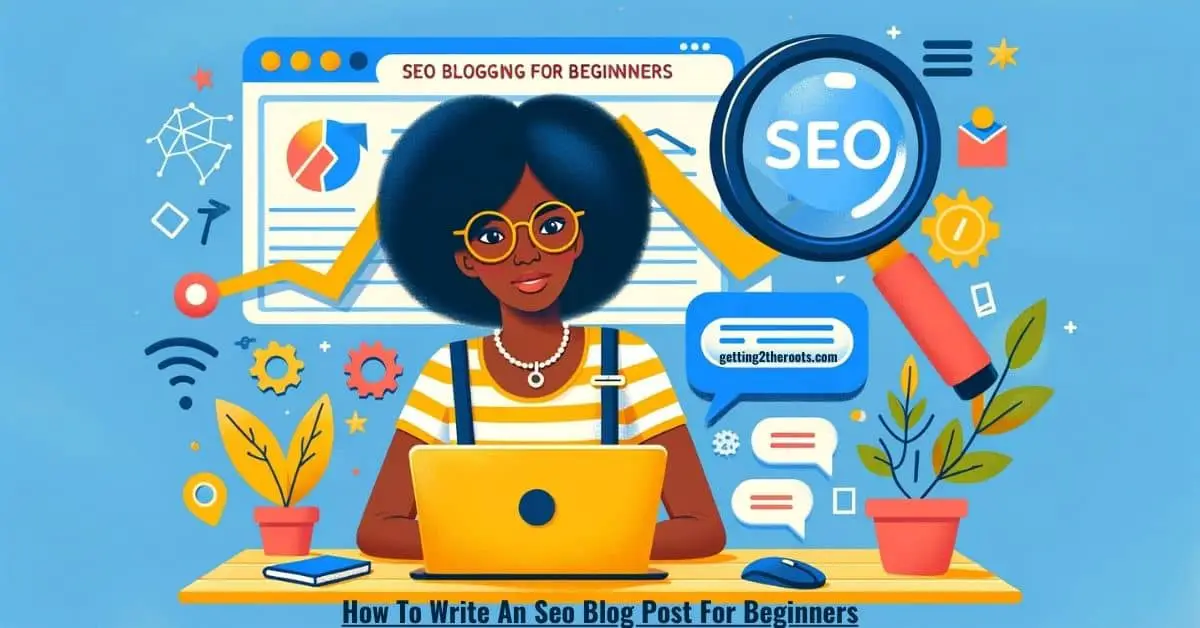Creating a compelling SEO blog post for beginners is a vital aspect of digital content creation. Whether it’s a detailed blog, engaging infographics, or any innovative content format, the essence of your online presence hinges on the quality of the material you offer.
In the vast digital landscape, your marketing efforts, social media engagement, and website appeal largely depend on captivating, reader-centric content.
Mastering the art of SEO blog posts, especially for beginners, involves more than just a flair for writing; it’s about strategically aligning your content with the needs and preferences of your audience.
When crafting an SEO-focused blog post, it’s crucial to not only consider who is reading your content but also what they seek from their online experience.
Engaging, relevant information is the key to retaining user interest and preventing them from navigating away.
As we dive into the world of SEO blogging, it’s essential for beginners to understand the intricacies of this field.
It’s not just about peppering your content with keywords; it’s about weaving a narrative that resonates with your audience, satisfies their quest for knowledge, and adheres to the algorithms of search engines.
This guide is designed to demystify the process of creating SEO blog posts for beginners, ensuring your journey into the realm of digital content is both fulfilling and successful.
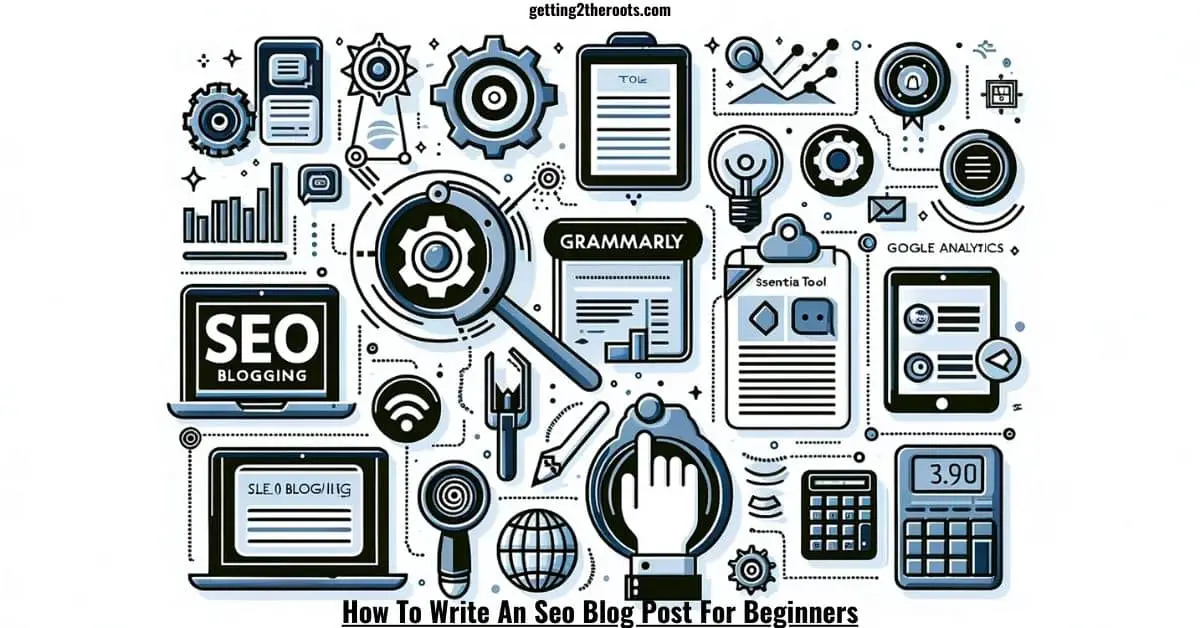
Essential Tips for Writing an SEO Blog Post: A Beginner’s Guide
Blogging stands as a powerful tool in carving out your unique identity within your industry. To magnetize readers and establish credibility, it’s imperative to craft blog posts that are not only current and relevant but also offer substantial value.
At the core of this endeavor is SEO (Search Engine Optimization), a critical component that cannot be mastered overnight.
Grasping the mechanics of SEO is pivotal for any beginner aspiring to make their mark in the blogging world.
Understanding how search engines operate and what elements contribute to a successful blog post are foundational steps in leveraging SEO to its fullest potential.
This section aims to unfold the nuances of SEO in blogging, guiding beginners through the labyrinth of optimizing their posts for better visibility and engagement.
As we delve into these tips, remember that the journey of SEO mastery is gradual, requiring patience, persistence, and a keen eye for evolving trends and algorithms.
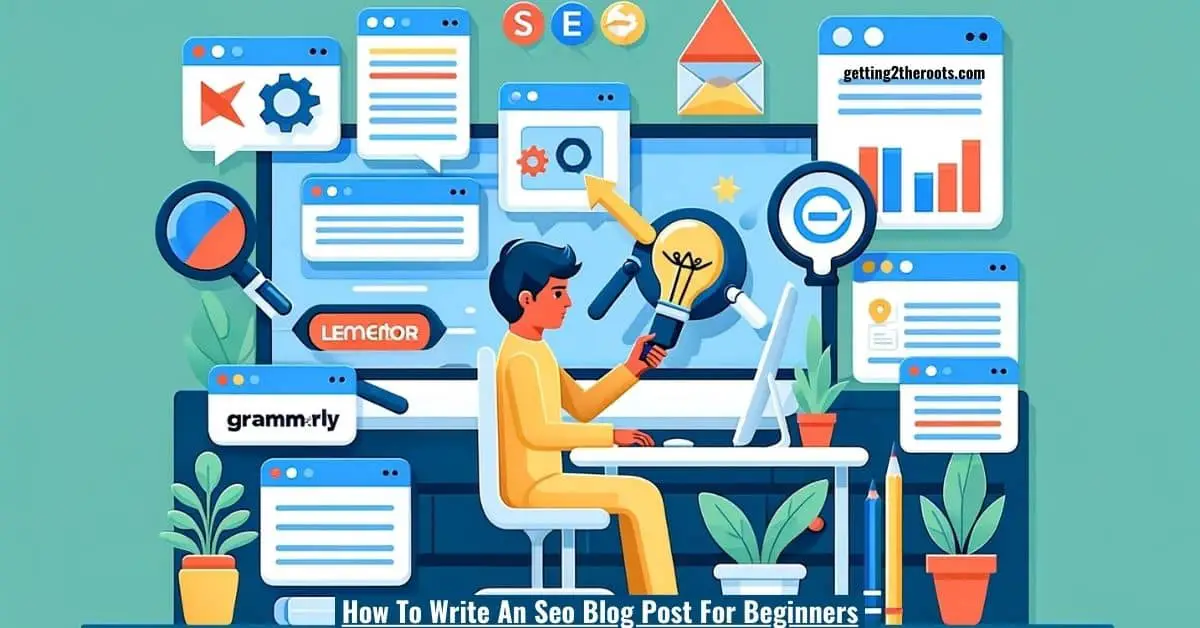
Strategizing Your Content: The Key to Effective SEO Blogging
Embarking on the journey of writing an SEO blog post, especially for beginners, calls for thoughtful preparation and strategy.
It’s highly recommended to explore resources like “How to Create Your Own Blog: 15 Best Tips” to gain deeper insights. Prior to crafting your blog post, invest time in understanding your audience’s needs and interests.
Resist the temptation to hastily select keywords without context, because your goal should be to curate content.
Content that not only incorporates relevant keywords but also presents the information in a manner that is both informative and engaging for your readers.
Remember, the success of your content on search engines like Google hinges not just on its quality but also on its relevance and demand.
Without aligning your content with the interests and queries of your target audience, even the most eloquently written posts may remain unseen.
This approach ensures that when you do write, each word contributes meaningfully to both your audience’s needs and your SEO goals.

Laying the Foundation: Structuring Your SEO Blog Post
- After pinpointing the topic for your SEO blog post, it’s crucial to develop a structured plan or outline.
- Your content blueprint may be as simple as a list of bullet points.
- Alternatively, it could be a comprehensive document that covers every aspect of your subject matter.
- The depth and detail of your outline are instrumental in streamlining the writing process.
A well-crafted outline serves as a roadmap, guiding you through the construction of your blog post.
It helps in organizing thoughts, ensuring that each paragraph flows logically into the next, and aligning with your overall message.
Additionally, a detailed outline aids in maintaining focus, particularly for SEO blog posts, where balancing informative content with keyword integration is key.
By investing time in this preparatory stage, you set the stage for a more fluid and efficient writing process, enabling you to create content that is not only coherent and compelling but also optimized for both readers and search engines.

Selecting the Perfect Title for Your SEO Blog Post
Choosing the right title for your blog post is a critical step in the SEO process. The title is your first opportunity to attract readers and search engines alike.
It should be carefully crafted to include relevant keywords, enhancing the discoverability of your content.
However, it’s vital to strike a balance; the title must remain engaging and natural, avoiding overuse of keywords that might come across as spammy and potentially harm your website’s ranking.
A well-chosen title serves as a beacon for potential readers, guiding them to your content amidst a sea of information.
It should encapsulate the essence of your post while also incorporating keywords in a way that feels organic and relevant.
This is not just about attracting clicks; it’s about setting clear expectations for what the reader will find in your article.
Remember, the title is often the deciding factor for whether a user clicks on your post or not. Therefore, take the time to create a title that is both SEO-friendly and appealing to your target audience.
This ensures it aligns with the content of your blog post and speaks directly to the interests and needs of your readers.
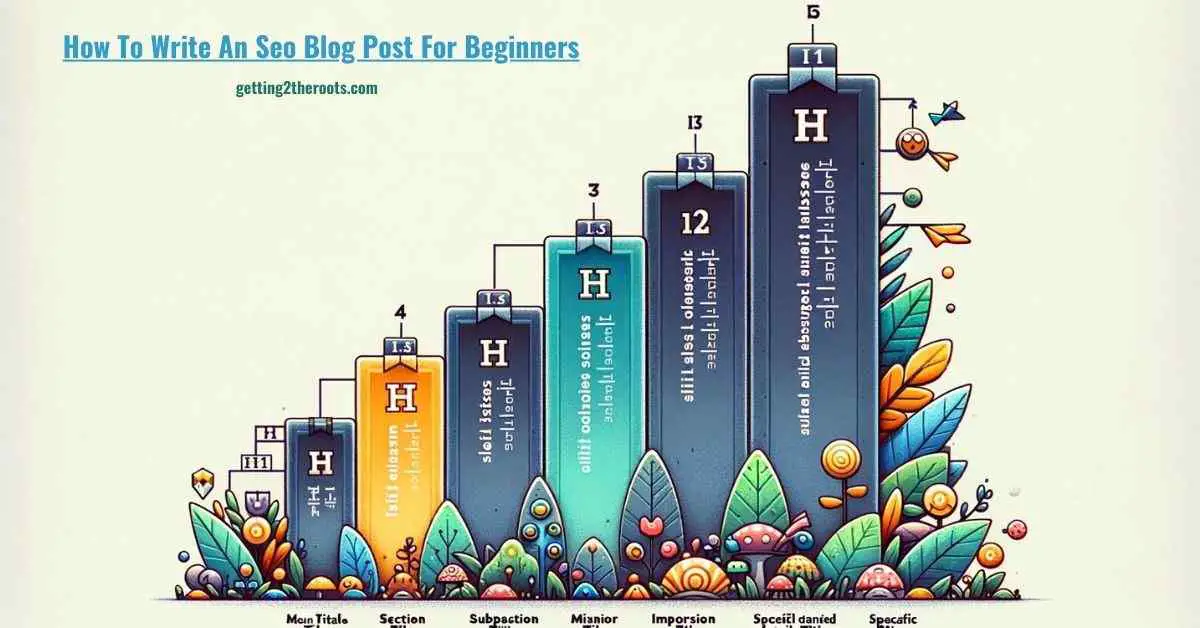
Use Headings Correctly
Headings are important parts of your content and help search engines understand what your page is about.
It helps readers navigate through the page without getting lost in the text since headings are bolded and highlighted by most browsers.
Use heading tags, making sure there are at least two tags on each webpage.
- H1 Heading:
- Represents the main title or headline of a web page.
- Usually the most important and largest heading.
- Should be used for the primary topic or subject of the page.
- Typically, there should be only one H1 tag per page.
- H2 Heading:
- Serves as a subheading to the H1 title.
- Used for main section titles under the primary topic.
- Helps to organize content into manageable sections.
- H3 Heading:
- Acts as a subheading to the H2 heading.
- Used for subsections under each main section.
- Provides further content organization and hierarchy.
- H4 Heading:
- A lower-level subheading under H3.
- Useful for breaking down H3 sections into smaller parts.
- Helps in the detailed organization of complex content.
- H5 Heading:
- Even more specific than H4.
- Used for subcategories within an H4 section.
- Ideal for detailed and extensive content structuring.
- H6 Heading:
- The lowest level of heading.
- Utilized for the least important subheadings.
- Often used in very detailed and lengthy web pages to provide structure.
- Each of these headings helps structure the content on a web page, making it more readable and accessible for both users and search engines. Proper use of these headings is important for SEO, as it helps search engines understand the structure and hierarchy of your content.

Writing Concise Paragraphs in Your SEO Blog Post for Beginners
In the realm of SEO writing, particularly for beginners crafting an SEO blog post, brevity is key.
Ensuring your paragraphs are short and to the point is not just a stylistic choice, but a strategic one.
Shorter paragraphs cater to the modern reader’s preferences, enabling them to quickly scan through the text and grasp the essential points.
When you’re writing an SEO blog post for beginners, remember that clarity and ease of reading are paramount.
Lengthy, dense paragraphs can be overwhelming and may deter readers from engaging with your content fully.
Concise paragraphs, on the other hand, facilitate a smoother reading experience. This approach also aligns well with SEO principles.
Search engines favor content that enhances the user experience, part of which is ensuring that information is easily accessible and understandable.
By keeping your paragraphs brief and focused, you not only cater to your readers’ needs but also optimize your posts for better search engine performance.

Strategic Linking in Your SEO Blog Post for Beginners
- Incorporating links into your SEO blog post for beginners is a nuanced art.
- It’s a tactic that SEO experts frequently advise.
- But with a key caveat: add links only when they genuinely enhance the reader’s experience and comprehension of your content.
- This approach not only aids the reader but also bolsters the credibility and depth of your post.
When delving into topics like social media marketing tools in your SEO blog post for beginners, it’s beneficial to link to these tools, offering your readers a direct pathway to further information.
This not only enriches your content but also provides practical value to the reader, making your post more engaging and informative.
Similarly, if your post explores email marketing automation software, including links to relevant websites or resources can significantly enhance your article.
It offers readers additional context or deeper insights into the subject matter, potentially increasing the time they spend on your post, which is a positive signal for search engines.
Avoid overlinking or forcing links in your content where they are not necessary. Prioritize maintaining the natural flow and integrity of your content, ensuring that links seamlessly integrate into the narrative.
Remember, while links are a powerful tool in SEO blogging for beginners, they should enhance rather than detract from the reader’s experience.
Their primary role is to serve the reader, providing them with a richer and more informative reading experience.

Balanced Keyword Usage in Your SEO Blog Post for Beginners
Effectively leveraging keywords is a cornerstone of crafting an SEO blog post for beginners. Keywords play a pivotal role in driving traffic to your blog, but their usage requires a delicate balance.
Overusing the same keyword can be counterproductive, as it not only detracts from the reader’s experience but also negatively impacts how search engines perceive your content.
As you write your SEO blog post for beginners, aim to incorporate your chosen keywords in a way that feels natural and organic within the context of your article.
The key is to sprinkle them throughout the content in a manner that enhances rather than disrupts the narrative flow.
This includes placing them in various sections of the article, from the introduction and body to the conclusion, but always in a way that maintains the quality and coherence of your writing.
Remember, the primary goal of using keywords in your SEO blog post for beginners is to make your content discoverable to the right audience without compromising on readability and engagement.
Search engines have evolved to prioritize content that provides value to readers, so while keywords are important for SEO, they should never overshadow the overall message and quality of your blog post.
Optimize Your Meta Description
The meta description shows up under the title of your blog post in Google search results. It should be 160 characters or fewer, including spaces, and should be written for humans rather than search engines.
A good meta description will tell readers about your post without giving away all the details. If possible, include a few keywords relevant to your post’s content, but not so many that it sounds unnatural.
For instance, in one of my successful articles, the meta description reads: “Unlock the secrets to a memorable black family reunion with our comprehensive guide.”
This particular post managed to rank on the first page of Google, a testament to the effectiveness of a thoughtfully constructed meta description.
Effective Solo Review Technique for Your SEO Blog Post for Beginners
For solo bloggers or one-person teams crafting an SEO blog post for beginners, conducting a thorough review of your content is still achievable and highly important.
This is particularly essential if your article includes technical terms or niche-specific language.
As a solo creator, I have adopted a unique and effective method for self-reviewing my content: using the free text-to-speech tool, TTSReader.
This alternative approach to traditional peer review has proven invaluable in enhancing the clarity and readability of my posts.
By inputting my written content into TTSReader, I can listen to my article being read aloud. This technique allows me to step into the shoes of my readers, giving me a fresh perspective on the flow, tone, and overall clarity of my writing.
It helps me critically evaluate how complex concepts are conveyed and assess their accessibility to readers, particularly those who might be new to the subject.
Hearing the text spoken can highlight subtleties in language and style that might be missed when reading it traditionally, aiding in refining the content to be more engaging and reader-friendly.
Furthermore, this solo review process is instrumental in identifying potential errors, from grammatical mistakes to factual inaccuracies, which could negatively impact the reader’s experience and the SEO effectiveness of the post.
By diligently reviewing my blog posts using this method, I can catch and rectify issues that could otherwise go unnoticed.
Employing this technique as a one-person team is not just about editing the content; it’s about ensuring its overall quality and effectiveness in communication.
This self-review process guarantees that my SEO blog post for beginners is not only informative but also optimized for search engines.
It also resonates well with my target audience, making it a valuable practice for solo bloggers like myself.

Key Tools and Resources for Crafting an SEO Blog Post for Beginners
For beginners embarking on the journey of SEO blogging, the right tools and resources are invaluable. These tools not only simplify the process but also enhance the effectiveness of your blog posts.
Whether it’s for conducting thorough keyword research, optimizing your content, or tracking the performance of your blog, a combination of both free and premium tools can significantly aid in your SEO endeavors.
Essential Content Creation and Optimization Tools:
- Elementor and Elementor Pro: These WordPress page builders, accompanied by add-ons like Essential Addons for Elementor, streamline the design process, enabling you to create both creative and SEO-friendly layouts with ease.
- Canva Pro: A must-have for elevating your blog’s visual appeal, this tool ensures that your content is not only engaging but also aesthetically pleasing.
Innovative Writing and Editing Tools:
- QuillBot and ChatGPT WP: These tools assist in generating and refining content, ensuring clarity and engagement in your writing.
- Writio: Streamlines the writing process with its user-friendly interface and helpful features, making it ideal for crafting SEO-optimized content.
SEO Analysis and Keyword Research Tools:
- All in One SEO: These tools are comprehensive in their offering, covering everything from detailed keyword research and site audits to in-depth SEO analysis, essential for crafting well-optimized content.
- LowFruits is an SEO tool that identifies low-competition keywords, simplifying the process of improving search engine rankings.
- Ubersuggest: It provides insightful keyword suggestions and competition analysis, aiding in the development of effective SEO strategies.

Performance Enhancement and Security Tools:
- Site Kit by Google: Integrates key Google tools into your WordPress dashboard, offering direct insights into your blog’s performance.
- iThemes Security and UpdraftPlus: Keep your blog secure and regularly backed up, protecting your SEO efforts.
- WP Rocket: Improves your site’s loading speed, which is crucial for both the user experience and SEO.
Email Marketing and Link Management Tools:
- Mailerlite, Active Campaign, and Constant Contact: This user-friendly platform is perfect for managing your email campaigns, a key element in promoting your SEO blog posts and engaging with your audience.
- Tools like Pretty Links and Broken Link Checker assist in managing and ensuring the functionality of the links in your blog posts, contributing positively to your overall SEO strategy.
- Social Warfare: A powerful plugin for social media sharing, helping to increase the reach and engagement of your blog posts.
Additional Resources for Enhanced Blogging:
- Unsplash: Provides access to high-quality images, which, when optimized with tools like Imagify, can keep your site fast and visually captivating.
- Pinterest: A valuable platform for promoting your blog and driving traffic, especially if your content includes visually appealing elements or targets lifestyle and hobby niches.
Video Content and Engagement:
- YouTube: Incorporating video content from YouTube can significantly enhance your blog posts.
These tools offer substantial assistance, the cornerstone of your blogging success lies in creating quality content that resonates deeply with your audience.
Remember, the key to successful blogging lies in creating content that is both informative and engaging, and these tools are here to help you achieve that.

Decoding SEO Analytics for Beginners: Measuring Your Blog Post’s Success
For beginners venturing into the world of SEO blogging, understanding basic SEO analytics is a vital skill.
It’s not just about creating an SEO blog post for beginners; it’s also about measuring its performance and success.
Analytics provide insights that can help you refine your strategy and improve your content. Here are some key metrics to focus on:
- Page Views: This metric indicates the total number of times your blog post has been viewed. Higher page views generally signify that your content is attracting attention. It’s a basic yet crucial metric that gives you a direct understanding of your blog post’s reach.
- Bounce Rate: The bounce rate measures the percentage of visitors who leave your site after viewing only one page. A high bounce rate could indicate that your content is not engaging enough or is not what the visitors expected. For an SEO blog post for beginners, aim to create content that captivates readers and encourages them to explore more of your site.
- Average Session Duration: This metric tells you the average amount of time visitors spend on your blog post. Longer session durations are generally better, as they suggest readers are thoroughly engaging with your content. To improve this, ensure your SEO blog post is informative, well-structured, and engaging.
- User Behavior Flow: Understanding how users navigate through your site can offer valuable insights. It helps identify which parts of your post are most engaging and which sections might need improvement.
- Traffic Sources: Knowing where your traffic comes from (search engines, social media, direct visits, etc.) can help you understand which of your marketing strategies are most effective. This insight is crucial for planning future SEO efforts for your blog posts.
Tools like Google Analytics or Site Kit by Google can be instrumental in tracking these metrics. They provide a comprehensive view of how your audience interacts with your content.
For beginners, regularly monitoring these analytics and using the insights to tweak your SEO strategies is essential for growth and success in SEO blogging.
Remember, the goal of analyzing these metrics is not just to gather data but to draw meaningful insights that can guide your future SEO efforts.
By understanding and acting on these analytics, you can continually improve the effectiveness of your SEO blog posts.
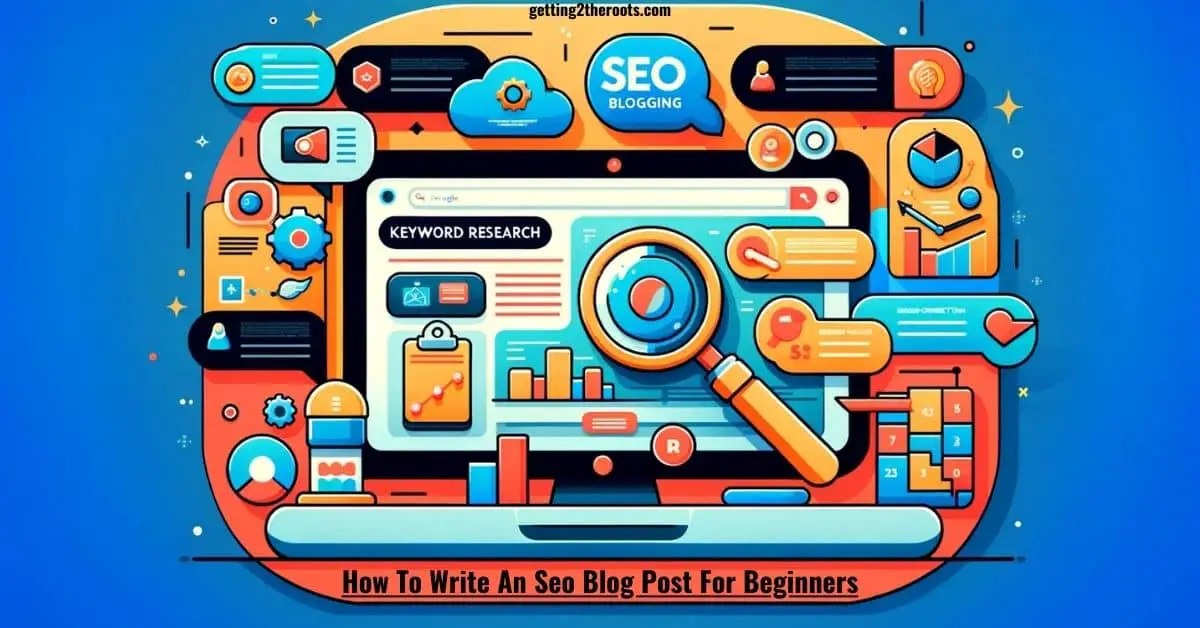
Keeping Up with SEO Trends and Updates: A Must for Beginners
Staying abreast of the latest trends and updates in SEO is crucial for anyone venturing into writing an SEO blog post for beginners.
SEO is a dynamic and ever-evolving field; strategies that are effective today might become obsolete tomorrow due to algorithm updates and shifting user behaviors.
Here’s how beginners can stay informed and adapt to these changes:
- Follow Industry Leaders and Blogs: Regularly reading blogs and following industry leaders like Moz, Search Engine Journal, and Neil Patel can provide valuable insights into current SEO trends and predictions for future changes. These resources often provide first-hand information on the latest developments in SEO.
- Engage in SEO Communities: Joining SEO forums and communities, such as those on LinkedIn or specific SEO subreddits on Reddit, can be a great way to stay informed. These communities are often the first to discuss algorithm updates, new tools, and effective strategies.
- Attend Webinars and Conferences: Many digital marketing and SEO conferences, webinars, and workshops are conducted throughout the year. Attending these events can provide deep insights into the industry and offer networking opportunities with SEO experts.
- Subscribe to SEO Newsletters: Subscriptions to newsletters from reputable SEO platforms can keep you updated with weekly or monthly summaries of the latest happenings in the SEO world.
- Monitor Your Own Site’s Performance: Keeping an eye on your website’s analytics can also signal changes in SEO trends. A sudden drop in rankings or traffic can indicate an algorithm change, prompting you to adjust your strategy.
- Experiment and Learn: The field of SEO is one where practical experience can be as informative as theoretical knowledge. Don’t hesitate to experiment with new strategies and see how they impact your blog’s performance.
For beginners in SEO blogging, understanding and adapting to these trends and updates is not just about following the industry’s direction.
It’s about developing an adaptable approach to SEO, ensuring that your content remains effective and your strategies are up-to-date. This continuous learning process is key to sustaining success in the ever-changing landscape of SEO.

Common SEO Mistakes to Avoid: Guidance for Beginners
When embarking on SEO blogging, especially for beginners, it’s just as important to know what not to do as it is to know the best practices.
Here, we will explore some common SEO mistakes that beginners often make and how to avoid them:
For beginners, avoiding these common SEO mistakes can be as critical as following best practices.
- Keyword Stuffing: Overusing keywords in your content can do more harm than good. It makes the writing sound unnatural and can lead to penalties from search engines. Instead, use keywords thoughtfully and sparingly, ensuring they fit naturally into your content.
- Neglecting Meta Descriptions and Title Tags: Meta descriptions and title tags are crucial for SEO, as they give search engines and readers a quick overview of your blog post. Make sure each post has a unique and descriptive title and meta description, using your main keyword.
- Ignoring Mobile Optimization: With the increasing use of mobile devices, having a mobile-friendly blog is essential. Ignoring mobile optimization can lead to a poor user experience and negatively impact your SEO.
- Creating Duplicate Content: Publishing content that’s too similar to existing content on your site can confuse search engines and dilute your search rankings. Always strive for unique, fresh content.
- Failing to Use Internal and External Links Effectively: Links are a vital part of SEO strategy. Not including relevant internal links can lead to missed opportunities for keeping readers engaged. Similarly, failing to include quality external links can diminish the credibility and depth of your content.
- Keyword Stuffing: Overusing keywords in your content can do more harm than good. It makes the writing sound unnatural and can lead to penalties from search engines.
- Meta Descriptions and Title Tags: Meta descriptions and title tags are crucial for SEO, as they give search engines and readers a quick overview of your blog post. Make sure each post has a unique and descriptive title and meta description, using your main keyword.
- Mobile Optimization: With the increasing use of mobile devices, having a mobile-friendly blog is essential. Ignoring mobile optimization can lead to a poor user experience and negatively impact your SEO.
- Failing to Use Internal and External Links Effectively: Links are a vital part of SEO strategy. Not including relevant internal links can lead to missed opportunities for keeping readers engaged. Similarly, failing to include quality external links can diminish the credibility and depth of your content.
- Creating Duplicate Content: Publishing content that’s too similar to existing content on your site can confuse search engines and dilute your search rankings. Always strive for unique, fresh content.
By being aware of these pitfalls, you can ensure that your SEO blog post not only attracts but also retains and engages your audience effectively.

Conclusion
As we wrap up our guide on how to write an SEO blog post for beginners, remember that SEO is a journey, not a destination. The landscape of SEO is constantly evolving, and so should your strategies.
By staying informed, avoiding common pitfalls, and consistently applying best practices, you can significantly improve the visibility and engagement of your blog posts.
Keep in mind the importance of creating content that not only appeals to search engines but also resonates with your readers.
Remember, the ultimate goal of SEO blogging is to provide value, answer questions, and solve problems for your audience.
With patience, persistence, and continuous learning, you’ll see your efforts pay off in the growth and success of your blog.
Frequently Asked Questions (FAQ): Creating an SEO Blog Post For Beginners
1. How often should I update my SEO blog post?
- Regularly updating your blog posts keeps them relevant and can improve SEO. Aim for updates every few months, especially if there are significant changes in your industry or topic.
2. Can I use multiple keywords in a single blog post?
- Yes, you can use multiple keywords, but focus on keeping your content natural and reader-friendly. Ensure that all keywords are relevant to the topic and integrated smoothly.
3. How important is the length of an SEO blog post?
- While longer posts often rank better, quality and relevance are more important. Aim for thorough, well-researched posts that comprehensively cover the topic.
4. Should every blog post have external links?
- Including relevant external links can add value, but they’re not mandatory for every post. Use them when they enhance the reader’s understanding or provide additional context

